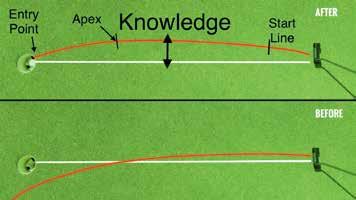
7 minute read
PUTT TO PERFORM
PUTT TO PERFORM
WORDS Brad Kennedy
Advertisement
Hopefully you’ve had some success with my chipping drills from last issue. This issue moves onto the number one asset in your golf bag - the putter.
Putts are approximately 40 per cent of your golf score, but it’s the least practised.
Think about your last round of golf. How many putts did you have relative to your score? How did you rate your putting last time you got out on the course? Poor? So, why aren’t you spending more time practising your putting?
Putting is often neglected because putting practice doesn’t get the adrenaline going like smashing out driver after driver on the range. If you want to drop shots off your score and lower your handicap, then get yourself onto the putting green regularly.
My best tournament results are also my best putting weeks. It’s no coincidence at the professional level — great putting is the key to success.
When you’re on the home stretch on Sunday afternoon, the pressure on your putting is intense. A missed or made putt could mean the difference between raising the trophy or not. My own practice is made up of 75 per cent short game and 25 per cent driving range.
Putting is an artform and has two main areas that need to be mastered — technique and green awareness (this is your ability to read a green, then hit every putt with good speed and distance control). The world’s best putters are masters in both these areas.
First, let’s look at technique. It is very important when putting, that you take the stance that makes you the most comfortable. This allows you to feel more confident over the ball. Your ideal putting stance and stroke is going to be
individual to you. This point is crucial, as it allows you to putt at your best.
3. Entry point — the point in which the ball will enter to maximise the size of the hole.
If you place a tee in the practice green two feet from you and your putt can hit that tee, then you have the natural ability to become a great putter. The best putters in the world have their own personal, natural stroke and this is what helps them perform. The same putting stroke can be repeated confidently and continually under pressure.
Next, is green awareness. Green awareness includes determining the green’s break and speed together with your distance control. All three are necessary skills to make more putts. If your putt has any element of break and you’re unable to read it properly (due to lack of knowledge), your chance of holing the putt is drastically decreased.

How to read the green is the difficult to master yet the most rewarding. If there is any element of break, it’s important to correctly identify this as the ball will travel from high to low with gravity following the contour of the green. If you can see the green flows right to left, then the ball will travel right to left, but how much it moves is where your skill and knowledge is tested.
There are three main keys when reading greens. Learn to identify these, as they will apply to the line of all putts:
1. Start line — a small target about 1-2 feet in front of the ball in which to hit your putt on its intended line.
2. Apex point — the highest point of the putt before the green’s contour will begin to break toward the hole.
The entry point will not always be directly a straight point towards the middle of the hole. Break will change this point. See image 1.
The best putters in the world can identify these points and visualise the path in which the ball will travel, then match it with the technical ability to execute the putt correctly.
Drill: Ladder drill for speed and distance control, 5-10mins (no hole required)
Most rounds you will have ten plus putts over five metres so this drill is designed to simulate what you will experience on the course. From this distance, it’s less than 18 per cent chance to make it, so the aim is to get it close enough to make sure you two putt during your round.
1. Place a tee in the green, then pace out five metres and put another tee in the green. Then walk one more metre and place another tee in the ground or lay a club down parallel to the tees.
2. Using three balls, putt the first ball to just past the tee.
3. Putt the second ball so it stops just past the first ball.
4. Putt the third ball and try and get it past the second ball without going over the end
5. If you achieve these three in order, move the start back from five-six metres and repeat.

6. With each successful three ball series, move the start back another metre. Try to get back to starting at ten metres.
7. At any stage if you leave a putt short of the previous ball or hit the club at the end, then re-start.
Challenge yourself to see how far you can get. You will be amazed at how great your distance control can become. This drill also helps your stroke acceleration through the ball, another skill great putters have. See image 2.
Drill: X drill. This works on start line, apex and entry point
The X drill challenges all your putting skills —uphill, downhill, right to left and left to right. See image 3.
1. Create an X around the practice hole so that you have 2x2 opposite putts (uphill versus downhill and right to left versus left to right)
2. Look at each of the four different putts to the hole. Identify the keys areas of start line, apex and entry point.
3. Pick any putt to start, place tees at 3, 4, 5, 6 and 7 feet. Start at three feet and putt. If you make it, continue back to four feet, etc. until you finish the 7-foot putt. If you miss a putt at any stage, then stay at that distance until you make it. Count how many putts to finish e.g. eight attempts to putt from all five spots.
4. Keep track of your score, then move to the opposite side and repeat the drill at 3, 4, 5, 6 and 7 feet.
5. Count the total putts you needed to complete that side.
6. Finish the other two sides repeating the same process and keep score.
7. When you have finished the X drill, you will have four scores. Totalling them will give you a combined score for the 20 putts to complete the drill. You will see which area needs the most improvement. Normally the left to right side is harder for a right-handed golfer.
The X drill is a what’s known as a performance drill. When done correctly, it should simulate everything you experience on the golf course, such as anxiety, fear, outcome, pressure. The more you practice in this pressure environment, the more you will learn to deal with these variables. This provides you with the tools to perform at your best.
I’m passionate about putting. It’s this skill that has allowed me to be consistently on tour for the last 25 years.
I’m also confident about the impact putting has on your score that I am setting you a challenge — practice your putting for the next month using the above drills. This will directly improve your scores for the month.


Spend at least three 20 minute sessions per week. Just before you play, warm up by hitting some golf balls on the range but any quality practice time you do is to be only putting. You will be surprised at the result.
For more tips and to access my putting aid, visit www.project1putt.com.au. Enter code MBGC at the checkout for a 10% discount (valid until 29 February 2020).
Friday 27 January 2020, at Sanctuary Cove Golf and Country Club I will be giving a putting demonstration open to all MBGC customers. To register, email events@mbgoldcoast.com.au. See you there!










